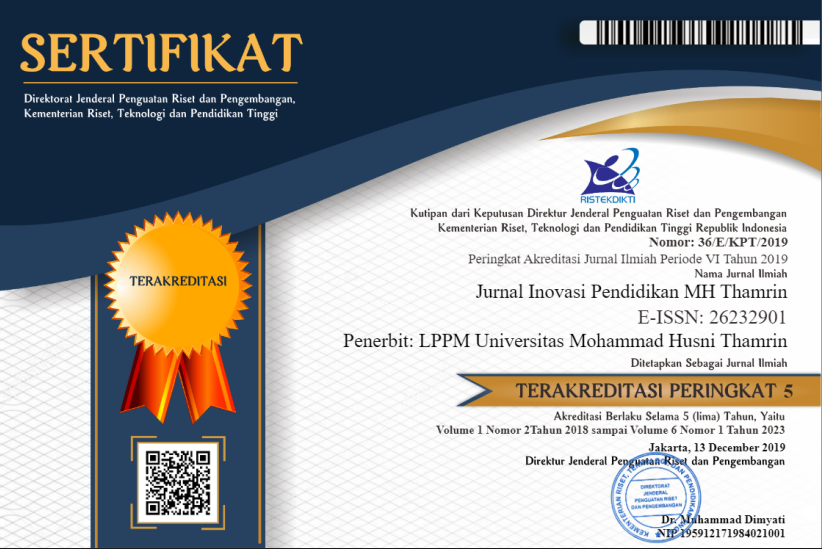Pengaruh Media Video Animasi Terhadap Hasil Belajar Tematik Siswa SD
DOI:
https://doi.org/10.37012/jipmht.v6i2.1334Abstract
References
Camacho, D. J., & Legare, J. M. (2015). Opportunities to create active learning techniques in the classroom. Journal of Instructional Research, 4, 38–45.
Daumiller, M., & Dresel, M. (2018). Supporting self-regulated learning with digital media using motivational regulation and metacognitive prompts. The Journal of Experimental Education, 1–16. https://doi.org/10.1080/00220973.2018.1448744
Derevenskaia, O. (2014). Active learning methods in environmental education of students. Procedia - Social and Behavioral Sciences, 131, 101–104. https://doi.org/10.1016/j.sbspro.2014.04.086
Dwyer, C. P., Hogan, M. J., & Stewart, I. (2014). An integrated critical thinking framework for the 21st century. Thinking Skills and Creativity, 12, 43–52. https://doi.org/10.1016/j.tsc.2013.12.004
Edwards, R. (2015). Knowledge infrastructures and the inscrutability of openness in education. Learning, Media and Technology, 40(3), 251–264. https://doi.org/10.1080/17439884.2015.1006131
Farisi, M. I. (2016). Developing the 21 st-century social studies skills through technology integration. Turkish Online Journal of Distance Education-TOJDE, 17(1), 16–30. https://doi.org/10.17718/tojde.47374
Heinrichs, C. R. (2016). Exploring the Influence of 21st Century Skills in a Dual Language Program: A Case Study. International Journal of Teacher Leadership Heinrichs - Exploring the Influence, 37(1), 37–56. http://files.eric.ed.gov/fulltext/EJ1137667.pdf
Hidayati, N., & Wuryandari, A. I. (2012). Media Design for Learning Indonesian in Junior High School Level. Procedia - Social and Behavioral Sciences, 67, 490–499. https://doi.org/10.1016/j.sbspro.2012.11.354
Inchamnan, W. (2016). An Analysis of Creative Process Learning in Computer Game Activities Through Player Experiences. IAFOR Journal of Education, 4(2), 119–139.
Khoiriyah, A. J., & Husamah, H. (2018). Problem-based learning: creative thinking skills, problem-solving skills, and learning outcome of seventh grade students. JPBI (Jurnal Pendidikan Biologi Indonesia), 4(2), 151–160. https://doi.org/10.22219/jpbi.v4i2.5804
Leong, S. S. M., Mohd Said, H., Shahrill, M., & Perera, J. S. H. Q. (2016). Using lesson study to enhance meaningful understanding on the topic of pressure. International Journal of Environmental and Science Education, 11(15), 8425–8435.
Pratiwi, S. S., Purwasih, J. H. G., Rozakiyah, D. S., Apriyadi, D. W., & Utami, I. W. P. (2021). Developing E-Module for Prospective Sociology Educators: Constructing Multiple Choice Questions Based on Higher Order Thinking Skill (HOTS). International Journal of Emerging Technologies in Learning, 16(7), 249–256. https://doi.org/10.3991/ijet.v16i07.21197
Sadiqin, I. K., Santoso, U. T., & Sholahuddin, A. (2017). Students ’ difficulties on science learning with prototype problem-solving based teaching and learning material : a study evaluation of development research. Advances in Social Science, Education and Humanities Research, 100, 279–282.
Stover, S., & Ziswiler, K. (2017). Impact of Active Learning Environments on Community of Inquiry. International Journal of Teaching and Learning in Higher Education, 29(3), 458–470.
Suhadi, S. M., Mohamed, H., Abdullah, Z., Zaid, N. M., Aris, B., & Sanmugam, M. (2020). Enhancing student’s higher order thinking skills (HOTS) through the socratic method approach with technology. In Research Anthology on Developing Critical Thinking Skills in Students (pp. 1399–1412). IGI Global. https://doi.org/10.4018/978-1-7998-3022-1.ch073
Sukiniarti. (2016). Improving Science Pedagogic Quality in Elementary School Using Process Skill Approach Can Motivate Student to Be Active in Learning. Journal of Education and Practice, 7(5), 150–157.
Yousefi, S. (2014). Comparison of traditional and video mediated learning of english: tracking a new approach. Procedia - Social and Behavioral Sciences, 98, 1940–1944. https://doi.org/10.1016/j.sbspro.2014.03.626
Yusuf, M. M., Amin, M., & Nugrahaningsih. (2017). Developing of Instructional Media-Based Animation Video on Enzyme and Metabolism Material. Jurnal Pendidikan Biologi Indonesia, 3(3), 254–257.
Downloads
Published
How to Cite
Issue
Section
Citation Check
License
Jurnal Inovasi Pendidikan MH Thamrin allows readers to read, download, copy, distribute, print, search, or link to the full texts of its articles and allow readers to use them for any other lawful purpose. The journal allows the author(s) to hold the copyright without restrictions. Finally, the journal allows the author(s) to retain publishing rights without restrictions Authors are allowed to archive their submitted article in an open access repository Authors are allowed to archive the final published article in an open access repository with an acknowledgment of its initial publication in this journal.

Jurnal Inovasi Pendidikan MH Thamrin is licensed under a Creative Commons Attribution 4.0 International License.











